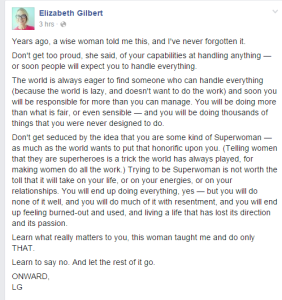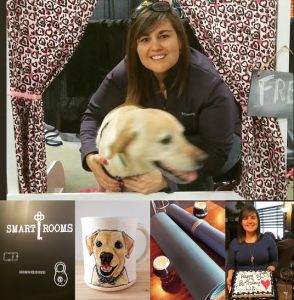My 30th birthday came and went without too much of a quarter/mid-life crisis. There were definitely freakout moments, mind you, but it helped that there were lots of reasons to celebrate the new decade I’m entering.
I’ve been surprised at how frequently I hear that your thirties are often considered the best decade of your life. That’s (supposedly) when you get a lot more clarity about who you are and what you want out of life, and you aren’t afraid to set boundaries to live that vision out (or so I’ve been told). I almost get the sense that you get past the superficial view of how your life should look and instead appreciate what is.
In that respect, I’m excited to start my 30’s. It seems to go hand in hand with what my “create” year is all about. I’ve recognized how important it is to cultivate attitudes, habits and a mindset consistent with who I want to be. It’s high time I stop wearing my busy badge all the time and calling that a life.
A couple weeks ago (on a day when I really needed to hear it) Liz Gilbert posted this fabulous message:

I think it struck me because a lot of my twenties were spent trying to be someone who could handle everything (or as I liked to call it, being “well-rounded and dependable”). I wanted to be Superwoman because I thought it meant having a fulfilling/satisfying life, or at least that I wouldn’t miss out on opportunities. It seemed like a surefire way to make my mark on the world and embrace life to the fullest.
Not so much.
At times it was certainly rewarding and it looked pretty good on paper (again, that superficial stuff), but it also came with a lot of exhaustion and resentment. In fact, I think that’s why Gretchen Rubin’s secret to adulthood that “you can choose what you do, but you can’t choose what you like to do” resonated so much with me. I was spending time and energy on things I wasn’t really designed to do or that I even enjoyed doing.
And this is apparently the stage in life when you start figuring that out. Perhaps not coincidentally, just yesterday this blog post articulated a similar message about turning 30 and reinforced Gilbert’s post. How are you going to spend your life? How do you shift from doing everything to focusing on the key things that bring fulfillment and joy?
What’s interesting is that I progressed on my 30 Before 30 list, I found myself picking up on that. It mattered less that I hit an arbitrary number of books and was more important that I read books that inspired me or changed my perspective on something. Whether I got to visit a new state or not didn’t matter. I was more excited about my travel companions and our shared experiences.
In some sense, it became more about the intangibles. Case in point: my new board of directors role. It’d been on my list to join a board, but before signing the dotted line, I attended two board meetings, had a meet-and-greet with the director and went to a fundraising event to make sure it felt like a good commitment. I didn’t just want to add something to my resume or cross an item off my 30 Before 30 list. I needed to be sure it was value-added to my life (and thus far it’s definitely been that).
That seems to be how my sisters approached planning my birthday weekend, too, which helped me focus less on my milestone age. Through some long-distance planning between the middle and the little, the celebration was more than I could have ever imagined. The sisters planned out three days of activities consistent with my “create” theme and full of events, people and canines I love.
Among other things, I got to go to the “I love my dog” expo with Hurley, managed to get through an escape room (which I’d never heard of before) with five minutes to spare, experienced a fabulously made drink at the speakeasy, got a pedicure, and went to Bottom’s Up, a yoga class offered at our favorite brewery in town. (Not bad googling for the little out on the east coast!)

The weekend, and other celebrations throughout the month, were really about being in the present and spending quality time with people who love, support and motivate me.
That, my friends, is how you bring on 30.
Although there’s still a bit of apprehension, I think I’m actually ready to take on the new decade in life. Let’s see if it lives up to the hype. 😉
(For those who are curious, there were five on-going goals on my 30 Before 30 list that I started but didn’t quite complete. And based on the content of this post, you probably guessed that I’m more than okay with that.)







